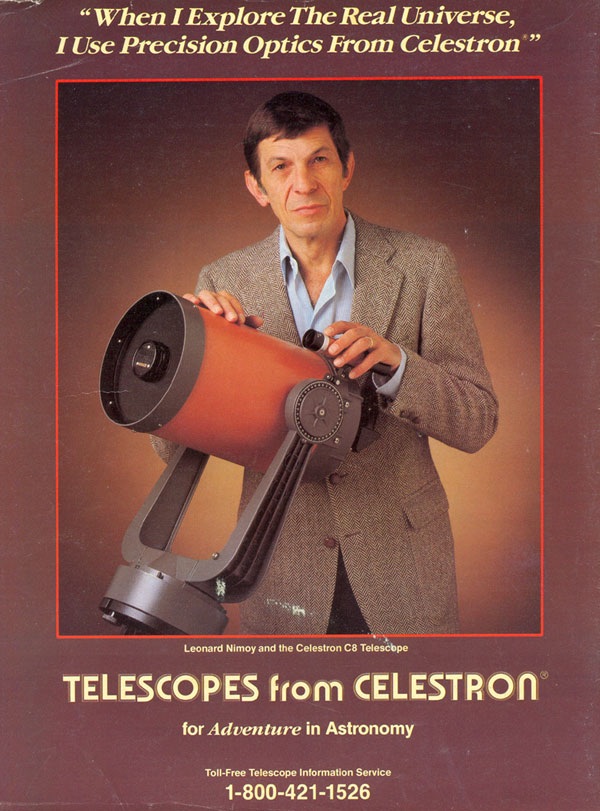The 8-Inch “Orange Tube” Schmidt-Cassegrain f/10 Telescope, Founder Tom Johnson, And Other
I pulled the following photo of (Leonard Nimoy) “Spock” and his “Orange-Tube” 8-inch Celestron Schmidt-Cassegrain telescope, from Phil Harrington’s vintage telescope advertisement post.
This is the telescope, that changed the world of amateur astronomy, with its introduction in 1970.
http://www.philharrington.net/old50.htm

Amateurs wanted a more compact and portable telescope, and the 8-inch Schmidt-Cassegrain f/10 fit the bill. I’ve owned two SC scopes over the years, but for me, I still like the simplicity of a Newtonian Reflector, despite the bulk and weight. And should a problem present itself, there is always an “easy fix” maybe not so much so with a Schmidt-Cassegrain or Maksutov-Cassegrain.
However, the Schmidt-Cassegrain telescope is the choice of telescope for many amateurs, for their own personal reasons. I’d suggest mostly for portability, and astrophotography.
Newtonian Reflectors:
It’s my opinion, a 10-inch “equatorially mounted” (solid tube) reflector, is the largest reflector that can/could be considered portable. And that’s a stretch, as I have a very heavy 10-inch EQ reflector (solid tube) so this is based on my experience.
However, this is not the case for a Dobsonian design, as many take 20 to 25-inch Newtonian’s, and sometimes “even” larger to star parties on a regular basis. But for me, I was always happy for someone else to bring such a large telescope. 🙂
My experience with a 20-inch Dobsonian:
I’ll never forget being at a star party near Blowing Rock/Boone, North Carolina, and climbing a “really” tall ladder, to observe through a 20-inch Dobsonian. To make things worse there was a 15 to 20 mph wind, and “of course” in total darkness. I couldn’t wait to get back on ground, and decided my 10-inch reflector was all I needed! I just never thought astronomy should be a hazardous hobby, even greater than road cycling!
I’ve always preferred the simplicity of both a Newtonian and refractors:
For me, growing up looking at big Cave Newtonian’s (advertisements) and other brands, with massive German design equatorial mounts, was what an astronomical telescope should look like.
We can never escape our early years, and thoughts.
Roger Ivester
The following is an excerpt from Wikipedia, concerning Tom Johnson and Celestron telescopes.
…..Johnson, who had a strong interest in amateur astronomy, originally created Celestron as the “Astro-Optical” division of Valor Electronics in 1960.[2][3] Around 1960, Johnson had been looking for a telescope which could be used by his two sons, but found no such child-friendly models on the market at the time.[2] Johnson built a new telescope, a 6-inch reflector telescope, by himself, in 1960.[2] He was visiting his brother in Costa Mesa, California when he came upon his nephew, Roger, trying to grind the 6 inch diameter lens he purchased from the clearance table at a local hobby shop. Roger was tired of the project and offered the lens-grinding kit to his uncle. Thomas Jasper took the kit home and after several days of hand grinding, he invented a machine that would grind the lens for him. Thus, by accepting the lens grinding kit from his nephew, Roger L. Johnson, “TJ” (as the family called him) created that first lens of many.
On July 28, 1962, he publicly unveiled a new invention, a portable 18+3⁄4-inch Cassegrain telescope, at the party held by the Los Angeles Astronomical Society on Mount Pinos.[3] The new transportable telescope proved so groundbreaking that Johnson’s invention was featured on the cover of a 1963 issue of Sky & Telescope.[3]
Johnson’s interest in telescopes soon became a full-fledged business.[2] Johnson’s new company, Celestron, which descended from the “Astro-Optical” division of Valor Electronics, soon began selling more sophisticated Schmidt–Cassegrain telescopes in models ranging from just 4 inches to 22 inches.[2] However, the Schmidt–Cassegrain telescope proved difficult to mass-produce because the models needed Schmidt corrector plate, an advanced aspheric lens, which could be hard to manufacture.[2] To solve this production problem, Johnson and the company’s engineers invented a new type of telescope, the Celestron 8, in 1970.[2] The Celestron 8 was more compact, affordable and easier to manufacture than traditional telescopes, like the Schmidt–Cassegrain.[2] Johnson’s new telescope proved very popular in the amateur astronomy and educational industries, allowing the hobby to rapidly expand and reach more consumers.[2]
Johnson sold Celestron in 1980.[2]
Explore posts in the same categories: Roger's Articles